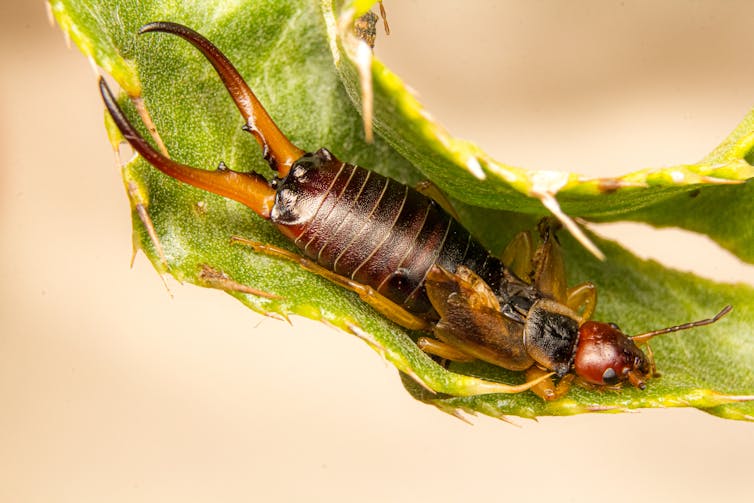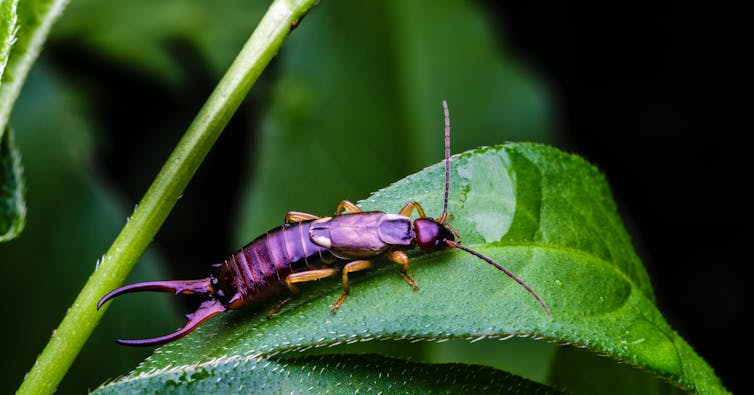Macronatura.es/Shutterstock
You lift a stone and staring up at you is a little insect with its tail curled and pincers ready to inflict who knows what. Then you see its attendants – tiny white insects, huddled underneath. Should you drop the stone and quash them, or leave them be?
What you have discovered is a family of one of Britain’s least loved, but one of the most caring insects – an earwig.
Only about 1% of insect species show parental care. Earwigs are one of them.
Females construct an underground chamber and lay 30 to 60 eggs which they protect and keep clean from fungi by “licking”. If a mole or another burrowing animal scatters her eggs, she diligently collects them together again.
They hatch after about 70 days, normally late winter. Searching for food in winter when predators are hungrier than usual is risky, but it helps the mother ensure her babies survive to adulthood because it means they can stay safely in their chamber until they are larger.
By the end of spring the baby “wiglets” have dispersed. The female may then have a second, smaller brood with eggs fertilised from the original mating.

Frauenversand Cleopatra/Shutterstock
Maternal tenderness seems to be built into an earwig’s genes as wiglets raised artificially later demonstrate nurturing to their own babies. Caring parents make the most of the opportunity to pass on their genes, despite the energy costs.
In contrast, there is a type of wasp which will seal her eggs in a nest with only enough food for a few larvae, leaving the strongest to eat their siblings. This is parental provisioning, rather than parental care.
Clever wings
Earwigs are unusual in other ways. They are members of the order Dermaptera (“skin wings”), a reference to their shortened, leathery front wings, also called tegmina. These protect the membrane-covered hind wings. Grasshoppers, stick insects and cockroaches have skin wings too.
Earwigs react to touch, known as showing positive thigmotaxis, so they habitually crawl into confined spaces. As an adaptation to this behaviour, their hind wings are folded under the tegmina. It is possible the name “earwig” comes from their ear-shaped hind wing, which is so intricately folded it has been studied for engineering solutions from self folding tents to space flight.

Tien Hong/Shutterstock
The word “earwig” comes from Old English ‘ēare’ (ear), and ‘wicga’ (insect). Several types of insects, including flies, moths and crickets enter people’s ears and have to be carefully removed.
But they will not bore into your brain, whatever stories your older siblings or classmates traumatised you with. Earwigs may enter human ears because they prefer close contact, not because they want to do you any harm.
When you consider the fact human activity has wiped out so many insects that nature is threatened with collapse, the idea of these insects as dangerous is laughable.

scott conner/Shutterstock
Not just for show
The most distinctive feature of European earwigs are their terminal forceps. Forceps are used for defence, to incapacitate prey, and in mating rituals. The forceps are straight in females and curved in males.
They differ between males too. Those with shorter, strongly curved forceps are called brachylabic. Males with long, straighter forceps are called macrolabic. Macrolabic males are more successful in mating and interrupt ongoing copulation involving less well-endowed earwigs.
One study examined the relationship between weapon size and the efficiency of earwigs’ immune system. It found forceps size trades off with haemocyte concentrations. In insects, haemocyte cells are crucial in the prevention of infection. Brachylabic males produced more haemocytes when infected with bacteria than macrolabic earwigs.

Wirestock Creators/Shutterstock
Just like us, earwigs can be a social bunch. In autumn, they release a pheromone that attracts other earwigs. This is primarily for mating, but earwigs aggregate in hibernation, a bit like ladybirds. Nymphs ? also produce pheromones to encourage maternal care.
Courtship involves the forceps. Males wave them in the air and use them to stroke and grasp the female, but they aren’t used in mating. The pair couples tail to tail for sperm transfer, which can take several hours.
Males and females can have multiple mates. They may stay together after the female has made a burrow and laid her eggs, but males usually return to the surface to forage, so don’t feed their wiglets.
Are earwigs good or bad?
They carry no known human pathogens but can use their forceps to deliver a slight nip. They are sometimes garden or horticultural pests. They damage plants, particularly dahlias, lettuce, strawberries, potatoes, and roses.
But earwigs benefit us too. As consumers of organic matter they speed up decay in compost. They are nature’s pest controllers, and on plants will eat aphids, mites, and insect larvae. If you’d prefer to keep your distance, they can be trapped using a damp, rolled up newspaper, or controlled by nonchemical methods, including diatomaceous earth (a natural rock that can be crumbled to a fine white powder).
Earwigs do enter houses through cracks and crevices and may collect in damp cellars, pantries, or bathrooms using their aggregation pheromone. But they do no harm to your house and won’t breed indoors.
They demonstrate the importance of maternal care and biological trade-off. They may help us better to design structures that can fit into small spaces but unfold into something much larger.
Perhaps people’s dislike for earwigs is similar to the reaction ants get, when you lift a stone and find a seething colony. Some researchers believe their sheer numbers threaten human desires to be individual and independent.
Here you are interrupting a mostly peaceful family life, with mother and wiglets startled by a sudden stab of light. Carefully replace the stone. They want to be left alone just as much as you do.
![]()
Christopher Terrell Nield does not work for, consult, own shares in or receive funding from any company or organisation that would benefit from this article, and has disclosed no relevant affiliations beyond their academic appointment.











